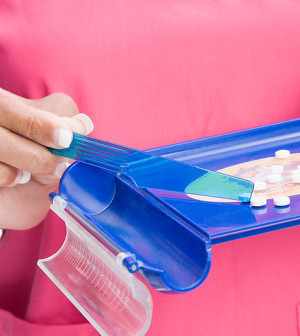- Navigating Your Midlife Crisis: Embracing New Possibilities
- City Raccoons Showing Signs of Domestication
- Mapping the Exposome: Science Broadens Focus to Environmental Disease Triggers
- One Week Less on Social Media Linked to Better Mental Health
- Your Brain Changes in Stages as You Age, Study Finds
- Some Suicide Victims Show No Typical Warning Signs, Study Finds
- ByHeart Formula Faces Lawsuits After Babies Sickened With Botulism
- Switch to Vegan Diet Could Cut Your Greenhouse Gas Emissions in Half
- Regular Bedtime Does Wonders for Blood Pressure
- Dining Alone Could Mean Worse Nutrition for Seniors
Can Drugmakers Buy Doctors’ Loyalty With Cheap Meals?

Doctors who accept free meals from drug companies are more likely to prescribe the brand-name drugs those companies sell, a new study suggests.
Physicians who received just one free meal, valued at less than $20 on average, were up to two times more likely to prescribe a promoted brand-name drug than a cheaper generic alternative, compared with doctors who did not accept a meal, the study found.
Doctors who received multiple meals were up to three times more likely to prescribe these drugs.
“To my surprise, tiny, tiny payments are associated with big differences in prescribing,” said study author Colette DeJong, a research fellow at University of California San Francisco’s (UCSF) Center for Healthcare Value.
Additional meals and pricier fare were linked with even higher prescribing rates of the promoted drug.
“So whether you get zero, one, two, three or four meals has a step-wise increase in the prescribing of the brand-name drug that’s being promoted, and that has huge implications for Medicare and huge implications for patients,” said DeJong.
Marketing guidelines established by the American Medical Association and Pharmaceutical Research and Manufacturers of America (PhRMA) allow meals and gifts to doctors worth up to $100.
Most of the meals in the study were of low value. “It’s more like the pizza in the doctor’s office than the formal dinner out,” DeJong noted.
That’s important, noted senior study author Dr. Adams Dudley, director of UCSF’s Center for Healthcare Value. It’s not the value of the gift driving doctors’ prescribing patterns; it’s “feeling like you owe the drug rep something,” he said.
Most Medicare beneficiaries are in prescription drug plans where the median copay is $1 for generics and $40 to $80 for brand-name drugs, DeJong noted.
“You can imagine for a senior on 10 or 20 medicines, that’s a huge cost every month,” she observed.
However, the study did not prove a cause-and-effect relationship. It may be that doctors attend industry events where information is provided on drugs they already prefer, the authors noted.
Dr. David Grande, an assistant professor of medicine at the University of Pennsylvania’s Perelman School of Medicine, in Philadelphia, thinks that’s unlikely.
“These findings provide even more support to do away with gifts altogether,” he said.
But PhRMA spokeswoman Holly Campbell took issue with the study.
“This study cherry-picks physician prescribing data for a subset of medicines to advance a false narrative,” she said in a statement.
Drug manufacturers routinely engage with doctors to share drug safety and efficacy information, new indications for approved medicines and potential side effects, Campbell noted.
What’s more, physicians’ prescribing patterns are greatly influenced by their clinical knowledge and experience as well patients’ individual needs, she added.
For the study, UCSF researchers linked information from two federal databases. One includes prescribing data for physicians in Medicare Part D (the prescription drug program). The other captures the value of food and beverages that drug makers provide to doctors.
The team identified the most-prescribed brand-name drugs in each of four common drug classes in 2013. These included Forest Laboratories’ beta blocker Bystolic (nebivolol) and Daiichi Sankyo’s ACE inhibitor Benicar (olmesartan medoxomil) — both for heart conditions, as well as AstraZeneca’s cholesterol-lowering statin drug Crestor (rosuvastatin calcium) and Pfizer’s antidepressant Pristiq (desvenlafaxine succinate).
None of the drugs in the study has an identical generic alternative. That was by design. Pharmacists often swap a brand-name drug for its generic equivalent, the researchers explained. Instead, the team picked popular brands within drug classes that have “great generic options,” DeJong said.
On many Medicare Part D plans, these drugs are “non-preferred,” she added. That means seniors pay more out-of-pocket than they would for generics or “preferred” brand-name drugs.
The study found nearly 280,000 physicians received roughly 63,500 payments totaling $1.4 million related to the four brand-name drugs. Ninety-five percent of payments were for meals, with an average cost of less than $20.
About 156,000 of those doctors wrote more than 20 prescriptions in at least one of the four categories.
Even after adjusting for other factors like prescribing volume, doctors who received a single meal were more likely to prescribe Crestor over other statins, Bystolic over other beta blockers, Benicar over other ACE inhibitors and Pristiq over other antidepressants.
The study was published June 20 in the journal JAMA Internal Medicine.
Payments for food and beverages provided to doctors totaled $224.5 million in 2014, JAMA Internal Medicine Editor-at-large Dr. Robert Steinbrook noted in an accompanying editorial.
“If drug and device manufacturers were to stop sending money to physicians for promotional speaking, meals and other activities without clear medical justification and invest more in independent bona fide research on safety, effectiveness, and affordability, our patients and the health care system would be better off,” Steinbrook concluded.
More information
To look up the value of meals your doctor received from drug representatives, go to the government website Open Payments.
Source: HealthDay
Copyright © 2025 HealthDay. All rights reserved.










